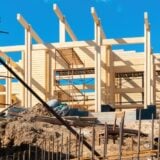Foreclosures increased 3% from August to 347,420 properties as lenders continued to work through the shadow inventory of distressed properties, according to RealtyTrac, which monitors the filings across the country.
Banks repossessed 102,134 properties in September, the first time REO reached triple digits for a single month. Foreclosures were filed on 930,437 properties in the third quarter, a 1% dip from last year but a 4% increase from the previous quarter. In the third quarter, one in 139 homes received a foreclosure filing, which includes default notices, scheduled auctions and bank repossessions.
REO for the third quarter reached a new record as lenders took back 288,345 properties, a 7% increase from the previous quarter and up 22% from last year. But as lenders work through the supply of serious delinquent loans, fewer are defaulting. RealtyTrac reported 269,647 default notices in the third quarter, down 22% from the peak in the third quarter of 2009.
‘Lenders foreclosed on a record number of properties in September and in the third quarter, taking a bite out of the backlog of distressed properties where the foreclosure process was delayed by foreclosure prevention efforts over the past 20 months,’ said James Saccacio, chief executive of RealtyTrac.
Saccacio added that he expects REO numbers to drop in the fourth quarter as several lenders work through recent foreclosure problems. ‘If the lenders can resolve the documentation issue quickly, then we would expect the temporary lull in foreclosure activity to be followed by a parallel spike in activity as many of the delayed foreclosures move forward in the foreclosure process,’ he explained.
But if lenders aren’t able to solve the problem quickly, the shadow inventory of distressed properties will grow, causing more pain to home prices.
For nearly four years, Nevada has posted the nation’s highest foreclosure rate. In the third quarter, one in 29 homes received a foreclosure filing, a 1% increase from the previous quarter but down 20% from a year ago.
Arizona was second for the fifth straight quarter, with one in every 55 houses receiving a filing. Florida was third with one in 56 and California was fourth at one in 70 houses. In terms of volume, California accounted for nearly 21% of foreclosure activity even though filings there are down 24% from last year.
Many economists are evaluating how the lack of rejuvenation in the property market will affect the economic recovery. Radar Logic analysts are sceptical that the market will improve in the meantime.
They believe that a delay in foreclosures could have a lasting positive effect on housing markets if sales of foreclosed homes are put off to a point in the future when the overall economy is healthier, housing demand is greater, and housing markets are better able to absorb the new inventory.
But they added that it is equally possible that delaying foreclosures will simply push the economic reckoning further into the future and any relief in the short term will be offset by pain in the middle or long term, with no net benefit to housing markets or the national economy.
Foreclosures in the US reach new records, latest figures show
- Share this
- Share on Facebook
- Share on Twitter
- Share on LinkeIn





